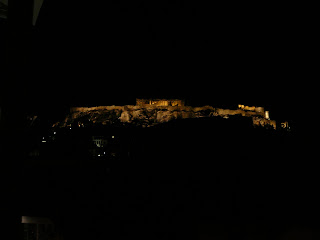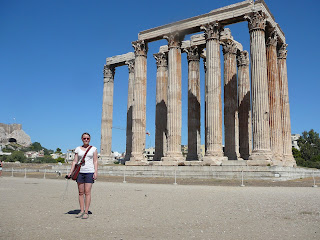In order to make it to Athens directly from Samos Island we had to take a twelve hour ferry during the day (disappointingly the overnight ferry is the one that comes from Athens to Samos). When we purchased our tickets our only choices were outside seating or inside seating for only about €10 more so we selected inside, but it turned out that we were in first class. Getting onto the boat was quite an exercise though as it arrived in the port at Karlovasi from Samos’ main port at Vathi and simply backed up to the port let down its walkway and driveway (for those transporting vehicles) and everyone began to try and get on at the same time. The boat was very comfortable with lots of leg room and comfortable seats which made the ride much more pleasant. However, one thing I learned from the large amount of children onboard is that they have the ability to run around and play all during the ride unlike on an airplane where they must sit still. There were kids playing catch and tag and babies crying and screaming for a large portion of the ride. Luckily as the owner of an iPod I was able to ignore most of it and try and get a bit of work done on my final grad school research paper.

The Nissos Mykonos (Our Ferry to Athens)
We made it into Athens and off the boat around 9pm and set out to find the metro station. Robby (who thankfully has a great sense of direction as I do not) had already figured out how to make it to our hostel in central Athens from the port via the metro. It took quite a bit of walking to get to station, but all in all it was simple journey. Although due to metro construction we were unaware off the train did not stop at our stop and continued on to the next. Not wanting to get too far out of the way we got off at the next stop and found a map to try and figure out how to get to our hostel. An older man on the stopped train called Robby over and told him that because of construction the train skipped our stop, but was now going back to it. After he told us this of course the train doors shut and it left the station to go where we wanted to be. We dragged ourselves down labyrinth of stairs to get to the other platform so that we could go back one stop. Fortunately our hostel was very close to the metro stop and after a minute walk we made it the hostel around 10pm. Exhausted we had one last hurdle before rest could come because our hostel room was on the fifth floor and there was no elevator! It was all worth it in the end because we had a breathtaking view of the Acropolis perched over the city and all lit up from our balcony.

Night view of the Acropolis

Monastiraki Square
The next day we tried to get an early start so that we could beat the heat and the crowds for our day if sightseeing in Athens. First we walked from our hostel in Monastiraki Square to the entrance on the northern slope of the Acropolis. We made it to the top of the Acropolis and to the main entrance at Propylaia. This section of the Acropolis is home to the Propylaia, the Beulé Gate, and the Temple of Athena Nike.

The Propylaia
The Propylaia formed the towering entrance to the Acropolis in ancient times. It was built between 437 BC and 432 BC by Mnesicles. It is made up of a central hall with two wings on either side. The stairs lead up the main section lined by columns to the beginning of the Panthenaic Way.

The Panthenaic Way
The Panathenaic Way cuts across the middle of the Acropolis and was the route taken by the Panathenaic procession. The Panathenaic procession was the climax of the Panathenaia festival which celebrated the birthday of Athena.

Temple of Athena Nike
The Temple of Athena Nike is a small square temple perched atop the southwest edge of the Acropolis, to the right of the Propylaia.

The Parthenon
After making our way up the stairs of the Propylaia we saw the grand jewel of the Acropolis – The Parthenon. History refresher courtesy of my trust Lonely Planet guidebook – the Parthenon was built on the highest part of the Acropolis to house the great statue of Athena by Pericles and to serve as the new treasury. It was designed by Ictinus and Callicrates, under the surveillance of Pheidias. It was built between 447 BC and 438 BC. While it appears simple in form the Parthenon’s perfect form was achieved through the use of optical illusions. In order for the foundation to appear perfectly level to the observer it is actually slightly concave. The columns are slightly convex to make them appear straight. Most of the damage to the Parthenon was caused by an explosion in 1687. You see during this time the Turks were storing gunpowder inside the Parthenon and when the Venetians attacked it caused an open fire on the Acropolis, causing an explosion in the Parthenon. More recently acid rain has been dissolving the marble.

Me & The Parthenon
Across the Panathenaic Way is the Erechtheion, built on the part of the Acropolis held most sacred. The spot is where myth tells us that Poseidon struck the ground with his trident and were Athena produced the olive tree. Wait you don’t know that story, well…

The Erechtheion
According to mythology, shortly after Kekrops founded a city on a huge rock near the sea the gods of Olympus proclaimed that the city should be named after the deity who could produce the most valuable legacy for mortals. Athena, the goddess of wisdom, produced an olive tree, symbol of peace and prosperity. Poseidon, the god of the sea, struck a rock with his trident and a horst sprang forth, symbolizing the qualities of strength and fortitude. The gods judged that Athena’s gift would better serve the citizens of Athens than the arts of war personified by Poseidon’s gift (again thank you Lonely Planet Greece).
Anyways back to the Erechtheion….it was named after Erichthonius, a mythical king of Athens. It is best known for its six large maiden columns that support its southern portico. These columns are known as the Caryatids because the models for them were women of Karyai who were known for the poise. The ones now at the Erechtheion are plaster casts of the originals. The five of the originals are housed in the new Acropolis Museum, while one was removed by Lord Elgin (a British architect who took many things from the Acropolis back to the museum in London). It was constructed between 421 BC and 406 BC.

The Caryatids
After descending part way down the southern slope of the Acropolis we came to the Theatre of Dionysos. The ruins are from the reconstructed theatre built between 342 BC and 326 BC, with a seating capacity of 17,000 spread over 64 tiers, of which about 20 remain.

Theatre of Dionysos
Next up was the Temple of Zeus, the largest temple in Greece. It was begun in the 6th century BC, but abandoned due to lack of money. It was left incomplete until Roman emperor Hadrian (who had a great fondness for Greek culture) completed it in AD 131. It was made up of 104 Corinthian columns (the ones that look like pineapples on top). There are 15 columns remaining today.

At the Temple of Zeus

Parliament Building in Syntagma Square
Following our visit to the Temple of Zeus we walked to Syntagma Square, home of the Parliament and the heart of modern Athens. From there we walked down the Plaka, the old Turkish quarter now full of shops. After stopping for a lunch of mousakka and a stop for frozen coffee at Starbucks we headed off to tour the Ancient Agora.

Walking Down the Plaka
The Ancient Agora was Athens’ central meeting place during ancient times. The Agora was the center of administrative, commercial, political and social activity in ancient Athens. Socrates spent a lot of time there expounding his philosophy and in AD 49 Saint Paul preached daily in the Agora attempting to win over converts to Christianity. The Temple of Hephaestus (449 BC) sits upon a hill overlooking the Ancient Agora. There is also a reconstruction of the now destroyed Stoa of Attalos, which housed expensive shops during ancient times and is now home to the Ancient Agora museum.

Temple of Hephaestus

Stoa of Attalos
After all that sightseeing we were starving so we stopped for a nice al fresco seafood dinner at a local restaurant. We enjoyed a salad with grilled Greek cheese and balsamic vinaigrette with pan-fried shrimp, mussels, calamari, and octopus. We took a post-dinner stroll up to the top of Filopappou Hill or the Hill of the Muses. The hill, which is located southwest of the Acropolis, is topped by the Monument of Filopappos, built to honor Julius Antiochus Filopappos a prominent Roman consul and administrator. The hill offers amazing sunset views and photo-ops of Athens, the Parthenon, and the Saronic Gulf.

Filopappou Hill from the Acropolis

Sunset over Athens from Filopappou Hill
Next Stop: Athens, part 2
No comments:
Post a Comment